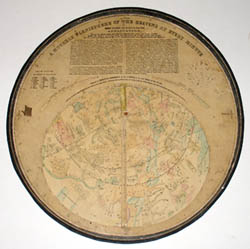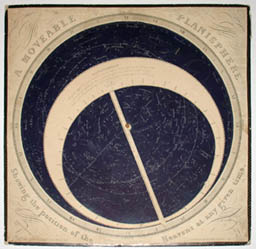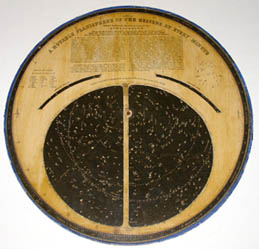American, 1856-1869

Round with Full Constellations, 1862 |

Square with Blue Background, 1856 |

Round with Black Background, 1862 |

Square with Black Background, 1869 |
Celestial Planispheres
Henry Whitall, New York & Philadelphia: 1856-1869
Hand-colored planispheres
Printed paper on cardboard, each with a central turning disk, some varnished
15 inches diameter to 15.5 inches square
Sold, please inquire as to the availability of similar items.
A group of 19th-century planispheres. A planisphere is a portable device that shows the stars and constellations visible in the night sky at any given date and time, generally for a particular locale. It consists of an outer rotating card with cutouts set against an inner hemispheric celestial map. The disk is rotated to match up the hour and minute of the day and compass points to printed data of day and month on the edge of the inner map, revealing the visible constellations within the cutout area. The disk is sometimes referred to by the antiquated word volvelle, used to describe rotating disks on various calculating devices.
Whitall's planispheres were made either round or square. The general format is as follows: They are comprised of printed text on cardboard and card. The overlaid printed outer card is a moveable disk, which rotates 360 degrees over an inner printed circumpolar map of the stars and constellations. In some of the planispheres, the constellations are shown in a graphic scheme of stars connected with dashed lines against black or dark blue backgrounds. In others, the constellations are pictorial illustrations of the mythological and scientific instruments for which they are named. Celestial and constellation regions are also labeled. The inner map is viewable through two semicircular cutouts of the rotating card divided by a central calibrated meridian strip. Usually, above the main cutouts, two narrow, curving slits show the skies when twilight begins and ends. The outer edges of the rotating disk are calibrated with hours and minutes, the inner edges of the rotating disk are calibrated with compass directions, all to be set against day and month calibrations on the outer edge of the inner printed map. The front of the outer card also displays keys listing the names of zodiacal and other constellations along with their stars, the Greek letters assigned to individual stars, as well as instructions. The backside of the device provides further extensive printed instructions.
An advertisement in a school trade catalog by McLees and Warren in 1876 promoted the Whitall planisphere as follows:
The Movable Planisphere is to Astronomy the same as a Map is to Geography, or to the clear sky what the Directory is to a City. It is the size of a 10-inch Celestial Globe, and as much better as it is cheaper. Of two kinds; one beautifully painted, the other as much like the sky as possible: Stars white on a deep blue-black ground. Both make a complete set. The two sent by mail on receipt of $6 or either for three dollars.
Whitall’s planispheres were designed for the observation of stars visible in a wide swath of North America centered on the latitude of Philadelphia. General instructions are printed on the front: “Bring the given hour and minute opposite the given day of the month; Hold the Zenith overhead with the Meridian in a line north and south. All the principal Stars visible in the United States will then appear within the Horizon.” The text on the back presents more detailed instructions and problems for students to solve.
Henry Whitall was a New York and Philadelphia publisher. Versions of his planispheres were published beginning in 1856 and were still being sold in a school supply catalogs in the later 19th century.
References:
Dekker, Elly, et al. Globes at Greenwich: A Catalogue of the Globes and Armillary Spheres in the National Maritime Museum, Greenwich. London: Oxford University Press and the National Maritime Museum, 1999. pp. 518-520.
Greenslade, Thomas B. Jr. "Planisphere of the Heavens." Instruments for Natural Philosophy, Kenyon College. http://physics.kenyon.edu/EarlyApparatus/Astronomy/Planisphere/Planisphere.html (20 December 2005).
Stott, Carole. Celestial Charts: Antique Maps of the Heavens. New York: Crescent Books, 1991. pp. 118-120.
